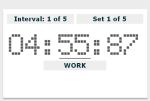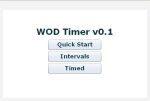The blood was pumping fast. My quads were about to burst. The lactic acid was overflowing as though it was about to start seeping out of the pores of my legs. Just 5 more seconds in this last set and I was done… possibly for good. Who would have thought that 12 minutes of work\rest intervals would lay me out like the way it did. I mean… Just 12 minutes?
That was my first Tabata based workout - a Crossfit oldie but goodie. 20 seconds of max possible air squats, 20 seconds of pushups and 20 seconds of box jumps, each followed by 10 seconds of rest, and repeat - 8 times. And the only thing I thought afterward was, “This is supposed to be good for me, isn’t it?” Can a 12 minute workout really be doing any good? And what does Tabata mean anyway?! So I set off on a quest to find out.
Unfortunately, figuring it all out means getting into the biochemical nitty gritty of things because at the end of the day, it’s all about the ATP. ATP (or Adenosine triphosphate) is a molecule used by our cells for energy. When muscles contract, they use a significant amount of ATP. In order to produce ATP (in an aerobic capacity), our cells oxydise glucose which means that in order for us to move we require a good amount of oxygen. The O2 goes in through our mouth, to our lungs, into our blood, to the muscles that are moving where it oxydises glucose to create ATP, creating CO2 as a by-product that goes back into our blood, back to the lungs and back out through our mouths. And this is why we start breathing heavily when we workout.
For the most part, our aerobic system does all this for us - keeps our muscles energized. However, when we want to use our muscles maximally, we are limited by the aerobic system. We, as human beings, can only take in so much O2 and our cardiovascular system can only move the O2 around so quickly. The state at which we are supplying oxygen to our muscles at the highest rate our bodies can handle is called our VO2 Max. While our muscles can typically operate at levels requiring a substantialy larger amount of oxygen, our VO2 max just can’t supply it all for us. So when we’re lifting really heavy or doing a high volume of highly muscular work, our aerobic system is unable to support the effort and our bodies turn to our anaerobic system for further energy requirements for our muscles.
The anaerobic system creates the additional ATP by way of glycolysis or oxidative phosphorylation - two ATP synthesis methods that require energy packets pre-stored in our muscles. Unfortunately these energy packets are in limited supply which means that we typically have a maximum of around 2 minutes of maximal work during which time lactic acid builds up and causes that good ol’ burning muscle sensation. After anaerobic energy is depleted, fatigue will set in and max work is no longer possible. Any work from here on out will likely be mostly of the aerobic kind.
Ok - have I lost you yet? What it boils down to is that our bodies are only so efficient at using oxygen for muscular energy and we can therefore only keep up at a high intensity for a relatively short duration. If it weren’t for this constraint, we could run a 5k at 100m sprint speeds. But while we will likely never be able to run a 5k that fast, we are fortunatly able to increase our cardiovascular and oxidation efficiency through regular bouts of high intensity interval training (HIIT). By practicing workouts consisting of intervals of high intensity followed by rest periods, it has been shown that we can increase the ability of our cardiovascular system to transport oxygen to our muscles and increase the ability of our muscular cells to use the oxygen for ATP synthesis. In short, HIIT training can help us attain better endurance.
So this is where Tabata comes in. Tabata is actually the name of the Dr. who first described the 20 seconds of maximal work followed by 10 seconds of rest. Dr. Izumi Tabata of the Department of Physiology and Biomechanics at the National Institute of Fitness and Sport in Kanoya City in Japan conducted a study in 1997 to look for an ideal ratio of work to rest for interval training in order to keep someone in a VO2 max state, maximally stressing both the anaerobic and aerobic systems throughout the entire workout. He found that the ratio of 2:1 was best and described the multiple sets of 20 seconds on, 10 off methodology as being most efficient.
So there you have it. Tabata is the name of a guy who took interval training to the next level by suggesting the most efficient way to do HIIT and train one’s endurance levels. And with that, it makes sense why we should subject ourselves to the hellish HIIT workout every now and then. The Tabata is a short, intense workout that can have a significant impact on one’s overall fitness level.
2 Comments | In: crossfit | tags: hiit, hit, interval training, intervals, tabata. | #
 Going for a 5 or 10 km run is a fantastic aerobic exercise that will burn lots of calories. However, the normal run is generally a moderate intensity exercise.
Going for a 5 or 10 km run is a fantastic aerobic exercise that will burn lots of calories. However, the normal run is generally a moderate intensity exercise.

